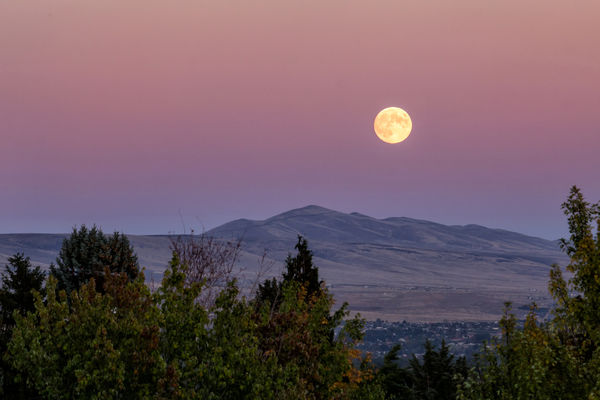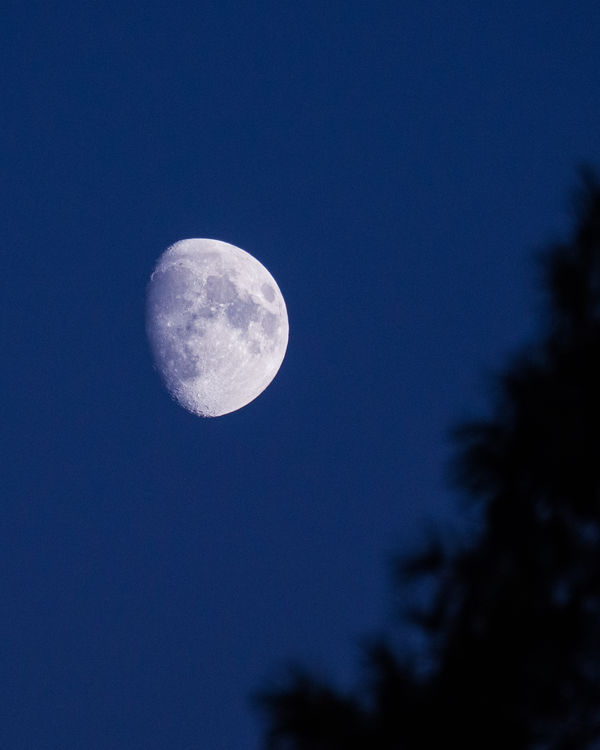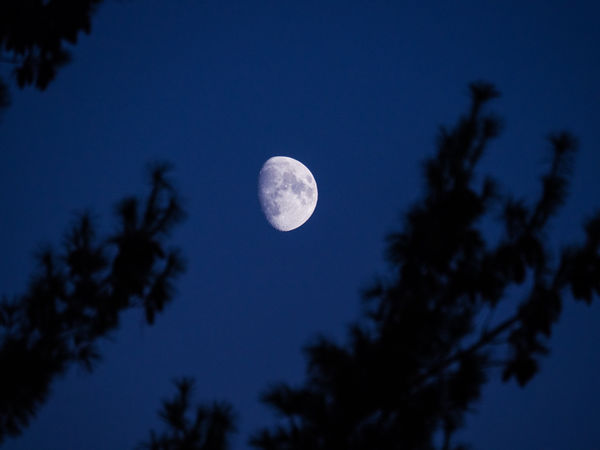A point that's often overlooked when discussing how to shoot a full moon
Oct 27, 2018 13:32:20 #
Architect1776 wrote:
Why I choose 100-400mm L MII with 2X MIII at f5.6, ISO 100 and 1/125 sec. is that is a good starting point.
The 100-400mm L MII is the same quality with or without the converter so I get an 800mm lens equivalent. (1,280mm view on my APSC camera)
The 100-400mm L MII is the same quality with or without the converter so I get an 800mm lens equivalent. (1,280mm view on my APSC camera)
The 100-400 v2 handles teleconverters well but there will ALWAYS be a hit in IQ. It may not be that noticeable with 1.4x (5%) but it's seen with a 2x (20-25%) definitely. In post sharpness can be partially recovered but there will be a loss in contrast. I've used both on my Canon 500 F4 and it's definitely visible with the 2x especially when compared to the native lens. On the 1.4x a small amount of sharpening is all that is required. There's never a free lunch with extenders. I can use both without loss of autofocus but there are trade offs.
Oct 27, 2018 13:33:12 #
Bobspez wrote:
Thank you for an easy to understand "why" and how I use iso-100, lowest available f-stop (lens wide ... (show quote)

Oct 27, 2018 13:35:15 #
JFCoupe wrote:
Many thanks for your time and interest! Atmospheric conditions (haze, thin clouds, humidity etc) are a huge factor in image clarity. I was hoping to keep this particular discussion more about exposure (at the moment, while the cats are still amenable to herding) for those who are struggling with the concepts. The idea of "random experimenting" causes me pain I think you points are very good and will be very ... (show quote)

Oct 27, 2018 13:36:18 #
Oct 27, 2018 13:38:07 #
larryepage wrote:
Thank you, Larry, especially for pointing out that brightness and whiteness are more about our personal choices than the reality A big plus is a location with dry, clear, air at a... (show quote)

Oct 27, 2018 13:43:59 #
Architect1776 wrote:
So bottom line start with the sunny 16 rule then adjust your camera to suit your taste and desire. It is all free so experimenting only costs a few minutes.
Gene51 wrote:
Thank you for your time, Gene and Architect!A full moon is flatly lit - so it will lack the shadows and contrast that help define crisp details. Even an almost full moon has better contrast than the full moon.
Though it is a bit of an urban legend, no "Sunny 16" here. Maybe Sunny 11 - nothing has changed with the moon - it's just that Sunny 16 doesn't and never did apply -
Though it is a bit of an urban legend, no "Sunny 16" here. Maybe Sunny 11 - nothing has changed with the moon - it's just that Sunny 16 doesn't and never did apply -

Wikipedia suggests "Loony 11"
https://en.wikipedia.org/wiki/Sunny_16_rule
My personal problem with "sunny 16" is I am losing up to three stops for no good reason. Since I hate tripods and have become rather wobbly, I need those 3 stops for shutter speed.
Olympus OMD EM-10 at 250 mm, f/6.7, 1/500 sec, ISO 400, shortly after sunset. Note the phase is less than full, helping to reveal craters on the edge.
I did raise the exposure 1 stop while in my raw editor. Also, to that end I changed WB from auto to "fluorescent" and my moon went from orangish to sparkling white - my personal preference for this one

Oct 27, 2018 13:48:30 #
Thanks for posting this thread Linda. Your words brought me back to Bryan Peterson's book "Understanding Exposure" describing how a well exposed image can be made with a multitude of settings. Many newcomers are looking for the magic formula. There are many combinations available, the key is finding the creative one. Personally I shoot a couple of stops up from wide open when photographing the moon.
Oct 27, 2018 13:51:34 #
lukevaliant wrote:
thanks again linda for posting such great topics i learn alot from you and jerry also 



Haydon wrote:
Luke and Haydon, thank you. I will have to remember the "there is no magic formula" phrase to share next time I lecture a newbie on the importance of understanding exposure Thanks for posting this thread Linda. Your words brought me back to Bryan Peterson's book "Understanding Exposure" describing how a well exposed image can be made with a multitude of settings. Many newcomers are looking for the magic formula. There are many combinations available, the key is finding the creative one. Personally I shoot a couple of stops up from wide open when photographing the moon.

Oct 27, 2018 13:55:24 #
abc1234 wrote:
The purpose of this thread is to assist newbies who don't understand what the "job" is. Explaining WHY someone chooses the settings they do is one way to achieve that goal. For example, I explained above why I need a fast shutter speed.. Forget about all this specific advice that says this or that lens or focal length. Likewise about exposure. Use what does the job at hand.
abc1234 wrote:
IMO focal length comes into play only when pointing out that if a moon fills just a tiny portion of your frame, you have to be realistic regarding how much cropping can be done. We see similar unrealistic expectations with bird photography. In cases like that, there are other options. For the moon, one option is to include it in a landscape at sunrise or sunset.Select a focal length that allows you to fill up the frame.
.
An old, old photo!

Oct 27, 2018 14:25:07 #
lukevaliant wrote:
ok i read the lens dif link and now my head hurts
ok i read the lens dif link and now my head hurts

Your head hurts ? Not your fault. It's not a good
article. All that stuff about wave interference is
overly complex and NOT very relevant.
What is relevant is that light beams bend a bit
off of their course upon encountering a crisp or
well defined physical edge. No need to realize
that those beams are made of waves. You can
easily ignore wave physics !
The edge of the aperture iris blades is a very
well defined edge, so it bends light beams off
of their normal path.
Any beams that aren't behaving in the manner
that the lens elements have "ordered them" to
behave are NOT part of the sharp well focused
image emanating from the lens elements.
At wide [large] apertures, and also at middle
apertures, the proportion of light beams that
never skim the edge of the aperture iris will be
hugely greater than the amount of beams that
get corrupted by skimming past the iris blades.
Realize that you'll have some corrupted beams
at every aperture setting, but when they are a
tiny fraction of the whole image they can't do
any visible damage.
The diffraction problem is due to the increase
in that "tiny fraction" at small apertures. The
amount of corrupted beams won't outnumber
the intact beams, but that minority of beams
that get corrupted by diffraction will become a
more influential minority and visibly degrade
the overall image.
Thaz the whole story. Take two aspirin and
forget about wave interference patterns :-)
`
Oct 27, 2018 14:29:51 #
Strodav
Loc: Houston, Tx
Architect1776 wrote:
Why is it obsolete?
Did things change with the moon?
It gets me there still just fine.
Did things change with the moon?
It gets me there still just fine.
Totally agree. I still use this rule as a sanity check on my camera meter's suggested settings. It is second nature to me and I find it helpful and comforting.
Oct 27, 2018 14:37:33 #
Strodav wrote:
Hopefully, everyone eventually learns enough about exposure to make informed choices that are right for themselves. I personally discovered a new level of happiness with auto-ISO Totally agree. I still use this rule as a sanity check on my camera meter's suggested settings. It is second nature to me and I find it helpful and comforting.

Oct 27, 2018 14:57:06 #
`
There is a widespread misunderstanding about
"Sunny 16". "Sunny 16" is a verrrry old piece of
advice and dates back to before AE and a time
when every user knew [and used] the reciprocal
relation between f/stops and shutter speeds.
The widespread misunderstanding about "Sunny
16" is when folks think of it as a recommended
camera setting, which it is NOT. What is is is ....
a mnemonic that offers a point of reference for
setting stops and speeds, in relation to ASA or
ISO speed, for outdoor lighting according to the
weather, between 10AM and 3PM, as applied to
ordinary scenes and subjects.
Basically, one should almost never actually set
their lens to f/16 at a shutter speed reciprocal
to the ISO speed. It's really just like planning
to have 2.358 children in your family. IOW it's
just a point of reference, not a practical reality.
`
There is a widespread misunderstanding about
"Sunny 16". "Sunny 16" is a verrrry old piece of
advice and dates back to before AE and a time
when every user knew [and used] the reciprocal
relation between f/stops and shutter speeds.
The widespread misunderstanding about "Sunny
16" is when folks think of it as a recommended
camera setting, which it is NOT. What is is is ....
a mnemonic that offers a point of reference for
setting stops and speeds, in relation to ASA or
ISO speed, for outdoor lighting according to the
weather, between 10AM and 3PM, as applied to
ordinary scenes and subjects.
Basically, one should almost never actually set
their lens to f/16 at a shutter speed reciprocal
to the ISO speed. It's really just like planning
to have 2.358 children in your family. IOW it's
just a point of reference, not a practical reality.
`
Oct 27, 2018 14:59:40 #
User ID wrote:
Most of us folks on UHH are very old There is a widespread misunderstanding about "Sunny 16". "Sunny 16" is a verrrry old piece of advice...

I agree about not recommending this whatever-classification-it-is to newbies.
Oct 27, 2018 15:07:34 #
Linda From Maine wrote:
Most of us folks on UHH are very old 
I agree about not recommending this whatever-classification-it-is to newbies.

I agree about not recommending this whatever-classification-it-is to newbies.
Here is an instructor's point of view on the subject.
Photos look pretty good to me.
https://www.picturecorrect.com/tips/photographing-the-moon/
If you want to reply, then register here. Registration is free and your account is created instantly, so you can post right away.




